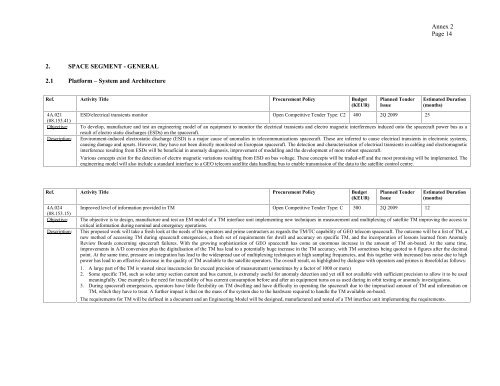ARTES-5.1 â ESA Telecom Technology Workplan ... - Emits - ESA
ARTES-5.1 â ESA Telecom Technology Workplan ... - Emits - ESA
ARTES-5.1 â ESA Telecom Technology Workplan ... - Emits - ESA
- No tags were found...
Create successful ePaper yourself
Turn your PDF publications into a flip-book with our unique Google optimized e-Paper software.
Annex 2Page 142. SPACE SEGMENT - GENERAL2.1 Platform – System and ArchitectureRef. Activity Title Procurement Policy Budget(KEUR)4A.021(08.153.41)Objective:Description:Planned TenderIssueESD/electrical transients monitor Open Competitive Tender Type: C2 400 2Q 2009 25Estimated Duration(months)To develop, manufacture and test an engineering model of an equipment to monitor the electrical transients and electro magnetic interferences induced onto the spacecraft power bus as aresult of electro static discharges (ESDs) on the spacecraft.Environment-induced electrostatic discharge (ESD) is a major cause of anomalies in telecommunications spacecraft. These are inferred to cause electrical transients in electronic systems,causing damage and upsets. However, they have not been directly monitored on European spacecraft. The detection and characterisation of electrical transients in cabling and electromagneticinterference resulting from ESDs will be beneficial in anomaly diagnosis, improvement of modelling and the development of more robust spacecraft.Various concepts exist for the detection of electro magnetic variations resulting from ESD on bus voltage. These concepts will be traded-off and the most promising will be implemented. Theengineering model will also include a standard interface to a GEO telecom satellite data handling bus to enable transmission of the data to the satellite control centre.Ref. Activity Title Procurement Policy Budget(KEUR)4A.024(08.153.15)Objective:Description:Planned TenderIssueImproved level of information provided in TM Open Competitive Tender Type: C 500 2Q 2009 12Estimated Duration(months)The objective is to design, manufacture and test an EM model of a TM interface unit implementing new techniques in measurement and multiplexing of satellite TM improving the access tocritical information during nominal and emergency operations.This proposed work will take a fresh look at the needs of the operators and prime contractors as regards the TM/TC capability of GEO telecom spacecraft. The outcome will be a list of TM, anew method of accessing TM during spacecraft emergencies, a fresh set of requirements for dwell and accuracy on specific TM, and the incorporation of lessons learned from AnomalyReview Boards concerning spacecraft failures. With the growing sophistication of GEO spacecraft has come an enormous increase in the amount of TM on-board. At the same time,improvements in A/D conversion plus the digitalisation of the TM has lead to a potentially huge increase in the TM accuracy, with TM sometimes being quoted to 6 figures after the decimalpoint. At the same time, pressure on integration has lead to the widespread use of multiplexing techniques at high sampling frequencies, and this together with increased bus noise due to highpower has lead to an effective decrease in the quality of TM available to the satellite operators. The overall result, as highlighted by dialogue with operators and primes is threefold as follows:1. A large part of the TM is wasted since inaccuracies far exceed precision of measurement (sometimes by a factor of 1000 or more)2. Some specific TM, such as solar array section current and bus current, is extremely useful for anomaly detection and yet still not available with sufficient precision to allow it to be usedmeaningfully. One example is the need for traceability of bus current consumption before and after an equipment turns on as used during in orbit testing or anomaly investigations.3. During spacecraft emergencies, operators have little flexibility on TM dwelling and have difficulty in operating the spacecraft due to the impractical amount of TM and information onTM, which they have to treat. A further impact is that on the mass of the system due to the hardware required to handle the TM available on-board.The requirements for TM will be defined in a document and an Engineering Model will be designed, manufactured and tested of a TM interface unit implementing the requirements.
















